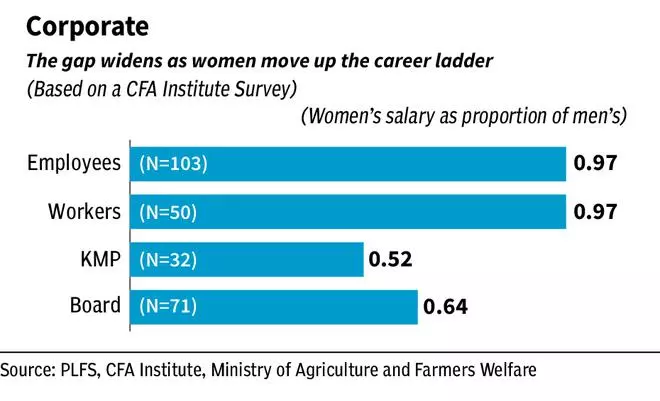A few weeks ago, American economist Claudia Goldin was awarded the Nobel Prize in Economic Sciences by the Royal Swedish Academy of Sciences. Goldin established through her research that women are “vastly underrepresented in the global labour market and, when they work, they earn less than men”.
Though Goldin’s research is about the gender pay gap in the US, the same holds true for India, too, across sectors. This conclusion is based on businessline’s analysis of the agri wages in the country, the Periodic Labour Force Survey, and the CFA Institute’s gender pay gap report. Our analysis also shows that women engaged in agriculture and in the salaried class make almost 20 per cent lesser than men. At the same time, pay gaps are wider as women move up the career ladder.
According to the estimates of the World Inequality Report 2022, in India, men earn 82 per cent of the labour income, whereas women earn 18 per cent of it.



Tilling hard
A woman agriculture field labourer makes ₹88 per day lesser than her male counterpart, according to the Ministry of Agriculture’s data for 2020-21. While a man is paid ₹383 a day on an average, a woman makes a mere ₹294 a day. The gap in their daily wages is more than the cost of two kilograms of rice.
This gap differs from State to State. Field labourers, for instance, make the most money in Kerala. While a man gets ₹789 per day, a woman is paid ₹537. While this is the highest amount paid to a woman labourer in a State, it is also ₹252 lesser than what her male counterpart was paid.
As of 2020-21, Tamil Nadu has the highest gender page gap among agriculture field labourers at 112 per cent. It is followed by Goa (61 per cent) and Kerala. The wage gap is the lowest in Jharkhand and Gujarat (6 per cent each), but the women labourers there get paid just ₹239 and ₹247 per day, respectively.
The salaried class
In the one-year period between July 2022 and June 2023, an average salaried Indian male made ₹20,666 in a month. A woman, on the other hand, made ₹15,722.25. Among the salaried class, the wage gap was the highest in Odisha (68 per cent), followed by Jharkhand (67 per cent) and Gujarat (62 per cent). Gujarat is also the State where an average salaried woman earned the lowest salary — ₹1,0419 per month.
According to Goldin’s research, part of the explanation is that educational decisions, which impact a lifetime of career opportunities, are made at a relatively young age. If the expectations of young women are formed by the experiences of previous generations – for instance, their mothers, who did not go back to work until the children had grown up – then development will be slow. She also noted that the bulk of the earnings difference between men and women in the same occupation largely arises with the birth of the first child.
At the same time, a report by the Pew Research Centre cited most women being treated differently by employers as a major reason for the pay gap. “Smaller shares point to women making different choices about how to balance work and family (42%) and working in jobs that pay less (34%),” it added.
Another report by the International Labour Organisation pointed out that a few reasons could be women’s under-representation in leadrship, career breaks and fewer working hours owing to other responsibilities.
Gap widens
A study by the CFA Institute, released in March 2023, showed that the pay gap widens as women move higher up in the career ladder. It noted that the median remuneration ratio of women to men was 0.52 for key managerial personnel (KMP) and 0.64 for directors. This means a woman holding a key management position makes just half the money that her male counterpart.
“Women, who are part of key management personnel, are paid roughly half the amount of their male counterparts,” noted the report, adding: “Some practitioners suggested that women might be overrepresented in company secretary roles, which are typically paid lower than other KMP. Even so, these low numbers overstate the actual experience because the number of data points is so small. Of the 112 companies that provided a breakdown of KMP remuneration by gender, 77 companies (69 per cent) had no women KMP at all.”







Comments
Comments have to be in English, and in full sentences. They cannot be abusive or personal. Please abide by our community guidelines for posting your comments.
We have migrated to a new commenting platform. If you are already a registered user of TheHindu Businessline and logged in, you may continue to engage with our articles. If you do not have an account please register and login to post comments. Users can access their older comments by logging into their accounts on Vuukle.